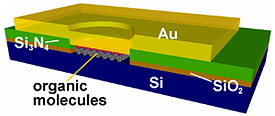| Posted: March 5, 2008 |
Good vibrations probe innards of molecular electronic junctions |
|
(Nanowerk News) Using an unusual spectroscopic technique, researchers at the National Institute of Standards and Technology (NIST) have provided the most convincing evidence yet that current is flowing through a simple silicon-based molecular “sandwich,” which is the most basic structure of molecular electronics. The work is an important step toward realizing the dream of organic molecule-based electronics that could enable much denser, cheaper computer memories and other replacements of traditional electronic devices ("Probing molecules in integrated silicon-molecule-metal junctions by inelastic tunneling spectroscopy").
|
|
“The ultimate in miniaturization is the molecule,” explains NIST’s Curt Richter. “The hope is that a single molecule will one day be able to act as an electrical component such as a diode or a resistor with the ultimate goal being shrinking computer chips.”
|
 |
| NIST researchers determined that the organic molecules in the middle of this simple silicon-based molecular “sandwich” pass electric current through these junctions by carefully measuring the minute changes in molecular vibrations. (Image: NIST)
|
|
For the past few years, scientists have been building and testing structures made of a hybrid of traditional silicon-based components and more futuristic molecule-based components. The typical junction is a sandwich of a metallic contact layer, a layer of organic compound just a single molecule thick arranged like bristles on a brush, and a substrate of silicon. Richter says that while the electric current seems to pass through the molecules, the current could be finding a way around it or the molecules could have been damaged in fabrication. Scientists want to know what is really happening inside this “black box.”
|
|
NIST researchers tried a little-used technique called inelastic electron tunneling spectroscopy (IETS) that measures the vibrations of the molecules inside the junction. “Each molecule has its own vibrational fingerprint,” says Wenyong Wang, adding “IETS acts as our eyes to see what is inside the black box.” An earlier paper by Wang and his colleagues at Yale University set IETS as a standard technique to prove that molecules remain intact in metal-based molecular electronic devices.
|
|
Colleagues at Purdue University provided three types of silicon-molecule-metal junctions that are a few micrometers large. The small molecules researchers used were octadecane, nitrobenzene and diethylaminobenzene.
|
|
Each silicon-molecule-metal device was cooled to cryogenic temperatures. Wang carefully measured the minute changes in the current passing through the junctions, and these current changes were then related to specific molecular vibrations. Thus, the researchers verified the existence of the molecules and that the electric current passed through them.
|
|
NIST physicists plan to continue research into silicon-molecule-metal junctions. “Once we understand the physics of the devices, we can begin to assess how viable the technology is and also determine which molecules may supply the best chance for a technological breakthrough,” says Richter.
|

